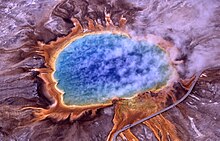Grand Prismatic Spring
Grand Prismatic Spring is the name of the largest hot spring in the United States and the third largest on earth . It is located in western Yellowstone National Park in the US state of Wyoming .
General
The basin is about 75 x 91 m and about 49 m deep. An average of 2000 liters of 71 ° C hot water flow from the spring every minute.
The colors come from unicellular microorganisms ( bacteria and archaea ) in the biofilm at the edge of the mineral-rich thermal spring. They move between green and red and depend on the chlorophyll and carotenoid content of the microorganisms that are adapted to the water temperature. In summer the biofilm tends to be orange and red, whereas in winter it tends to be dark green.
The water in the center of the spring is free of microorganisms due to the prevailing temperatures. The deep blue color of the relatively small body of water is due to the depth of the water and the high level of water purity in the center of the spring.
history
The earliest records on this source are from early European explorers and surveyors .
In 1839, a group of trappers from the American Fur Company crossed the Midway Geyser Basin and wrote a note about a "boiling lake of 300 feet, " which is about 90 feet , which might apply to Grand Prismatic Spring .
In 1870, the Washburn-Langford-Doane expedition visited the source and also reported a nearby geyser (now Excelsior Geyser ) that was "50 feet" (about 15 m).
Web links
Individual evidence
- ^ Steam Explosions, Earthquakes, and Volcanic Eruptions — What's in Yellowstone's Future? . In: US Geological Survey . Retrieved September 14, 2005.
- ^ Grand Prismatic Spring . In: Geyser Observation and Study Association (GOSA) . 2006. Archived from the original on March 12, 2007. Info: The archive link was automatically inserted and not yet checked. Please check the original and archive link according to the instructions and then remove this notice. Retrieved May 23, 2006.
- ^ Thomas D. Brock: Colorful Yellowstone . In: Life at High Temperatures . Archived from the original on February 12, 2005. Retrieved July 25, 2014.
- ^ Charles L. Braun, Sergei N. Smirnov: Why Is Water Blue? . 1993. Retrieved May 23, 2006.
- ^ VII. "The Fire Hole": Era of the American Fur Company, 1833-1840 . In: Colter's Hell & Jackson's Hole - The Fur Trappers' Exploration of the Yellowstone and Grand Teton Park Region . Retrieved September 14, 2005.
- ^ Notes . In: Yellowstone National Park: Its Exploration and Establishment . Retrieved September 14, 2005.
- ↑ Part II: Definitive Knowledge - The Washburn Party (1870) . In: Yellowstone National Park: Its Exploration and Establishment . Retrieved September 14, 2005.
Coordinates: 44 ° 31 ′ 30 " N , 110 ° 50 ′ 18" W.

